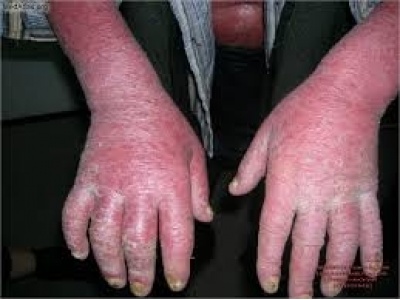
Toxic epidermal necrolysis (TEN), also known as Lyell's syndrome, is a rare, life-threatening skin condition that is usually caused by a reaction to drugs. The top layer of skin (the epidermis) detaches from the lower layers of the skin (thedermis) all over the body.
TEN is a more severe form of Stevens–Johnson syndrome. There is debate about whether it falls on a spectrum of disease that includes erythema multiforme. Some authors consider that there is an overlap between the two syndromes (usually between 10% and 30% of skin detachment).
The incidence is between 0.4 and 1.3 cases per million each year.
Signs and symptoms
TEN affects many parts of the body, but it most severely affects the mucous membranes, such as the mouth, eyes, and vagina. The severe findings of TEN are often preceded by 1 to 2 weeks of fever. These symptoms may mimic those of a common upper respiratory tract infection. When the rash appears it may be over large and varied parts of the body, and it is usually warm and appears red. The dermal layer fills with fluid being deposited there by the body's immune system, usually as a result of a negative reaction to an antibiotic. The skin then begins to sag from the body and can be peeled off in great swaths. The mouth becomes blistered and eroded, making eating difficult and sometimes necessitating feeding through a nasogastric tube through the nose or a gastric tube directly into the stomach. The eyes are affected, becoming swollen, crusted, and ulcerated and blindness may occur.
Diagnosis
Often, the diagnosis can be made clinically. Generally, if the clinical history is consistent with Stevens–Johnson syndrome, and the skin lesion covers greater than 30% of the body surface area, the diagnosis of TEN is appropriate. Sometimes, however, examination of affected tissue under the microscope may be needed to distinguish it between other entities such as staphylococcal scalded skin syndrome. Typical histological criteria of TEN include mild infiltrate of lymphocytes which may obscure the dermoepidermal junction and prominent cell death with basal vacuolar change and individual cell necrosis.
Nikolsky's sign is almost always present in toxic epidermal necrolysis.
Quite often misdiagnosis is made during the early stages of TEN. Symptoms are often mistaken for chicken pox, scarlet fever, and various other conditions. This in turn results in the offending drug still being used or prescribed, leading to devastating results.
Treatment
The first line of treatment is early withdrawal of culprit drugs, early referral and management in burn units or intensive care units, supportive management, and nutritional support.
The second line is Intravenous immunoglobulin (IVIG). Uncontrolled trials showed promising effect of IVIG on treatment of TEN; a randomized control trial is needed in the future to determine the efficacy of IVIG in TEN.
The third line is cyclosporin, cyclophosphamide, plasmapheresis, pentoxifylline, N-acetylcysteine, ulinastatin, infliximab, and/or Granulocyte colony-stimulating factors (if TEN associated-leukopenia exists).

